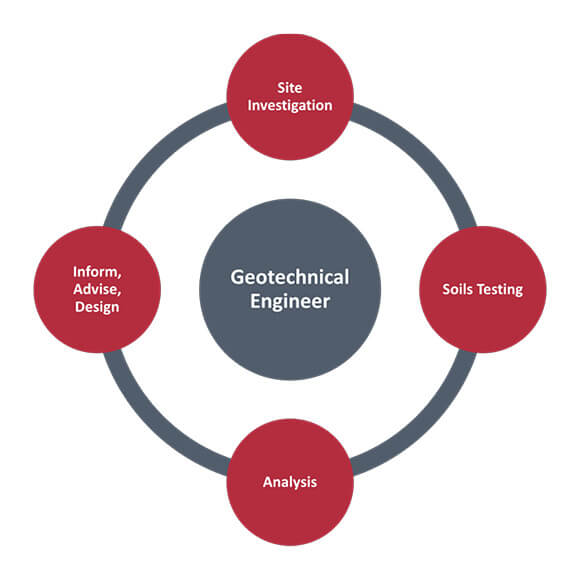Fascination About Geotheta
Fascination About Geotheta
Blog Article
The Of Geotheta
Table of ContentsExamine This Report about GeothetaThe Facts About Geotheta Revealed5 Simple Techniques For GeothetaExcitement About GeothetaHow Geotheta can Save You Time, Stress, and Money.

They perform website examinations, accumulate samples, perform research laboratory tests, and analyze data to assess the viability of the ground for building projects - Geo Tech Engineer. Based upon their searchings for, geotechnical engineers give referrals for structure layout, slope security, keeping frameworks, and reduction of geotechnical risks. They team up with other specialists, such as architects, structural engineers, and construction teams, to guarantee that geotechnical considerations are incorporated right into the total job layout and execution
By analyzing the behavior and buildings of soil and rock, they can recognize potential geotechnical risks such as landslides, dirt settlement, or slope instability. Their know-how assists prevent failures or accidents that might threaten lives and building. Here are some thorough duties and duties of a geotechnical designer: Site Investigation: Geotechnical designers conduct website examinations to collect data on subsurface conditions.
They interpret the information to recognize the homes and behavior of the dirt and rock, including their stamina, leaks in the structure, compaction characteristics, and groundwater conditions. Geotechnical Evaluation and Style: Geotechnical designers assess the information gathered throughout website investigations to analyze the security and suitability of the website for building tasks. They perform geotechnical calculations and modeling to evaluate aspects such as bearing capability, settlement, incline stability, lateral planet pressures, and groundwater circulation.
The 9-Second Trick For Geotheta
Structure Design: Geotechnical designers play an essential role in designing structures that can securely sustain the designated framework. They evaluate the soil problems and load needs to establish the proper foundation kind, such as superficial foundations (e.g., grounds), deep structures (e.g (https://slides.com/geotheta)., piles), or specialized methods like soil improvement. They take into consideration elements such as settlement restrictions, bearing ability, and soil-structure interaction to develop optimum foundation layouts
They review construction strategies, monitor site tasks, and perform area evaluations to verify that the design suggestions are adhered to. If unanticipated geotechnical issues develop, they evaluate the situation and provide recommendations for removal or adjustments to the design. Threat Analysis and Mitigation: Geotechnical designers evaluate geotechnical threats and threats connected with the project site, such as landslides, liquefaction, or dirt disintegration.

Collaboration and Interaction: Geotechnical engineers function very closely with various other experts associated with a task, such as architects, structural engineers, and building and construction groups. Efficient communication and partnership are important to incorporate geotechnical factors to consider into the overall project style and construction process. Geotechnical designers offer technological know-how, answer inquiries, and ensure that geotechnical needs are met.
Geotheta Can Be Fun For Anyone
Here are some kinds of geotechnical designers: Foundation Designer: Foundation engineers focus on developing and examining foundations for structures. They examine the soil conditions, lots requirements, and site qualities to determine the most proper structure kind and design, such as shallow foundations, deep foundations, or specialized techniques like pile foundations.
They examine the variables influencing incline stability, such as soil properties, groundwater problems, and slope geometry, and develop strategies to stop incline failings and minimize risks. Quake Designer: Quake designers specialize in analyzing and developing frameworks to stand up to seismic pressures. They examine the seismic risk of a site, evaluate soil liquefaction potential, and establish seismic design standards to guarantee the security and durability of structures during quakes.
They do field testing, collect examples, and evaluate the accumulated information to identify the dirt properties, geologic developments, and groundwater problems at a website. Geotechnical Instrumentation Designer: Geotechnical instrumentation designers concentrate on tracking and measuring the habits of soil, rock, and frameworks. They set up and preserve instrumentation systems that check variables such as soil settlement, groundwater levels, slope motions, and structural displacements to evaluate performance and supply early warnings of potential problems.
9 Simple Techniques For Geotheta
They perform examinations such as triaxial examinations, consolidation examinations, direct shear tests, and permeability tests to gather data for geotechnical analysis and style. Geosynthetics Designer: Geosynthetics designers specialize in the style and application of geosynthetic products, such as geotextiles, geogrids, and geomembranes. They use these materials to boost soil stability, reinforce slopes, provide water drainage options, and control disintegration.
They tend to be investigative individuals, which suggests they're intellectual, reflective, and analytical. They are curious, systematic, logical, logical, and rational. Some of them are likewise social, suggesting they're kind, generous, participating, person, caring, valuable, compassionate, sensible, and friendly - Tailings Engineer.
In the workplace atmosphere, click for more info geotechnical designers utilize specialized software program devices to execute computations, create designs, and assess data. They prepare records, testimonial project specifications, interact with clients and employee, and coordinate task tasks. The workplace setup offers a conducive atmosphere for study, evaluation, and cooperation with other professionals associated with the task.
The 6-Minute Rule for Geotheta
They often check out project sites to carry out website investigations, examine geotechnical conditions, and gather information for analysis. These brows through entail traveling to different locations, often in remote or tough surfaces. Geotechnical engineers may carry out soil tasting, conduct tests, and screen building and construction tasks to ensure that the geotechnical elements of the project are being executed appropriately.
Geotechnical designers additionally function in specialized geotechnical labs. Geotechnical lab engineers function thoroughly in these environments, dealing with screening tools, operating instruments, and videotaping information.
Report this page